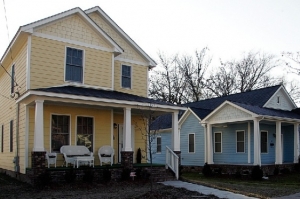DGDC sets sights on new brands of homeowners
By Kenneth Fine
Published in News on January 13, 2010 1:46 PM

News-Argus/BOBBY WILLIAMS
The Downtown Goldsboro Development Corp. is currently developing a new approach to its downtown housing program designed to offer more families the chance to own one of the group's new, historic-looking homes.
Despite a recent announcement that the Durham-based Self-Help organization was pulling out of Goldsboro after the first phase of construction of subsidized housing on John Street, Downtown Goldsboro Development Corp. executive director Julie Thompson said the move -- which she describes as temporary -- brought with it positive news: There is an interest in market-rate housing located in the city's core.
And her logic, she said, is rather simple. When Self-Help was marketing its three properties on John, only one buyer met HUD's ownership guidelines. But when those guidelines were lifted, the other two homes sold within 90 days.
"When we started the neighborhood plan, we really thought there were two ways to go. There was affordable housing and market rate. But at the time, we didn't think there was much of a market for market rate. I mean, who would want to come in ... and build? We thought it was a harder sell," Mrs. Thompson said. "What we thought was, let's emphasize affordable housing. We had a partner (Self-Help) that was willing to go out on a risk and build the homes and then sell them. And the thought was that later on, as we progress, we would carve out a piece for the market rate."
But the high level of interest in the three homes built on John -- and their quick sales after those HUD guidelines were lifted -- told a different story, she said. It exemplified the notion that there were people interested in buying homes downtown, subsidized or not.
So by next month, she hopes to pitch to the City Council a new plan: Find a private contractor willing, with the right incentives, to construct houses in line with the spirit of what Self-Help was trying to accomplish, replacing empty lots and areas of blight in certain downtown neighborhoods with historic-looking, owner- occupied homes.
But there will still be a need in the future for subsidized housing, Mrs. Thompson said. And she expects Self-Help to be involved when that time comes.
But making the partnership work down the road would require another move by the City Council. It would likely, Mrs. Thompson said, have to staff the undertaking of finding people who meet HUD's requirement -- Self-Help having to do that work from afar became a burden they simply could not continue to handle.
"The low- to moderate-income bracket we had to meet was so narrow, it was really hard to find these people, and (Self-Help) didn't have the time to do it," Mrs. Thompson said. "But we still want to make sure we don't displace that low- to moderate-income, basically the work force. And I think, to that end, there is still hope (Self-Help) will come back. They really enjoyed working in Goldsboro."
It is still unclear whether DGDC staff will present its new plan at a regular board meeting next month or at the City Council retreat scheduled for the middle of February.
But one thing seems clear, Mrs. Thompson said: There are dozens of families interested in moving to the downtown area.
"And that's the really exciting, good news," she said.
Self-Help's relationship with Goldsboro began several years ago when a plan to construct affordable homes as part of the city's neighborhood revitalization efforts came to fruition.
The three homes built on John Street during the first phase of its operation were designed to look like historic houses from the late 19th and early 20th centuries.
The project was part of the Comprehensive Historic Neighborhood Revitalization Plan, which addressed the need to create single-family, owner-occupied homes in a neighborhood associated with blight, distress and decline.
Qualifying for these homes under HUD guidelines meant several things: The purchaser must have been a first-time homebuyer or someone who hadn't owned a home in the past three years, and their household income could not exceed a certain income limit -- for a household of one, the income limit was $26,400; for two people, the limit was $30,150; for three, four and five people in the household, the limits were $33,950, $40,700 and $43,750.
